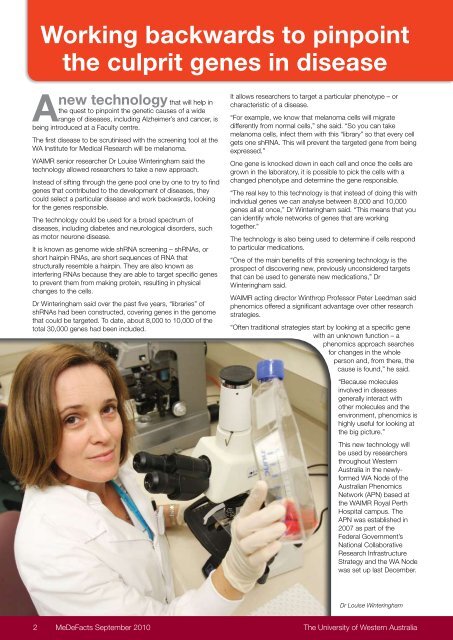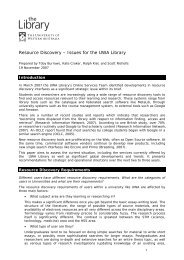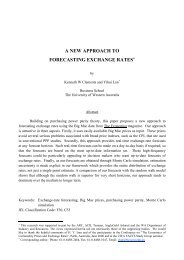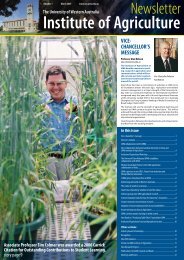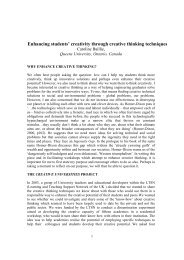MeDeFacts September 2010 - The University of Western Australia
MeDeFacts September 2010 - The University of Western Australia
MeDeFacts September 2010 - The University of Western Australia
Create successful ePaper yourself
Turn your PDF publications into a flip-book with our unique Google optimized e-Paper software.
Working backwards to pinpoint<br />
the culprit genes in disease<br />
a<br />
new technology that will help in<br />
the quest to pinpoint the genetic causes <strong>of</strong> a wide<br />
range <strong>of</strong> diseases, including Alzheimer’s and cancer, is<br />
being introduced at a Faculty centre.<br />
<strong>The</strong> first disease to be scrutinised with the screening tool at the<br />
WA Institute for Medical Research will be melanoma.<br />
WAIMR senior researcher Dr Louise Winteringham said the<br />
technology allowed researchers to take a new approach.<br />
Instead <strong>of</strong> sifting through the gene pool one by one to try to find<br />
genes that contributed to the development <strong>of</strong> diseases, they<br />
could select a particular disease and work backwards, looking<br />
for the genes responsible.<br />
<strong>The</strong> technology could be used for a broad spectrum <strong>of</strong><br />
diseases, including diabetes and neurological disorders, such<br />
as motor neurone disease.<br />
It is known as genome wide shRNA screening – shRNAs, or<br />
short hairpin RNAs, are short sequences <strong>of</strong> RNA that<br />
structurally resemble a hairpin. <strong>The</strong>y are also known as<br />
interfering RNAs because they are able to target specific genes<br />
to prevent them from making protein, resulting in physical<br />
changes to the cells.<br />
Dr Winteringham said over the past five years, “libraries” <strong>of</strong><br />
shRNAs had been constructed, covering genes in the genome<br />
that could be targeted. To date, about 8,000 to 10,000 <strong>of</strong> the<br />
total 30,000 genes had been included.<br />
2<br />
It allows researchers to target a particular phenotype – or<br />
characteristic <strong>of</strong> a disease.<br />
“For example, we know that melanoma cells will migrate<br />
differently from normal cells,” she said. “So you can take<br />
melanoma cells, infect them with this “library” so that every cell<br />
gets one shRNA. This will prevent the targeted gene from being<br />
expressed.”<br />
One gene is knocked down in each cell and once the cells are<br />
grown in the laboratory, it is possible to pick the cells with a<br />
changed phenotype and determine the gene responsible.<br />
“<strong>The</strong> real key to this technology is that instead <strong>of</strong> doing this with<br />
individual genes we can analyse between 8,000 and 10,000<br />
genes all at once,” Dr Winteringham said. “This means that you<br />
can identify whole networks <strong>of</strong> genes that are working<br />
together.”<br />
<strong>The</strong> technology is also being used to determine if cells respond<br />
to particular medications.<br />
“One <strong>of</strong> the main benefits <strong>of</strong> this screening technology is the<br />
prospect <strong>of</strong> discovering new, previously unconsidered targets<br />
that can be used to generate new medications,” Dr<br />
Winteringham said.<br />
WAIMR acting director Winthrop Pr<strong>of</strong>essor Peter Leedman said<br />
phenomics <strong>of</strong>fered a significant advantage over other research<br />
strategies.<br />
“Often traditional strategies start by looking at a specific gene<br />
with an unknown function – a<br />
phenomics approach searches<br />
for changes in the whole<br />
person and, from there, the<br />
cause is found,” he said.<br />
“Because molecules<br />
involved in diseases<br />
generally interact with<br />
other molecules and the<br />
environment, phenomics is<br />
highly useful for looking at<br />
the big picture.”<br />
This new technology will<br />
be used by researchers<br />
throughout <strong>Western</strong><br />
<strong>Australia</strong> in the newlyformed<br />
WA Node <strong>of</strong> the<br />
<strong>Australia</strong>n Phenomics<br />
Network (APN) based at<br />
the WAIMR Royal Perth<br />
Hospital campus. <strong>The</strong><br />
APN was established in<br />
2007 as part <strong>of</strong> the<br />
Federal Government’s<br />
National Collaborative<br />
Research Infrastructure<br />
Strategy and the WA Node<br />
was set up last December.<br />
Dr Louise Winteringham<br />
<strong>MeDeFacts</strong> <strong>September</strong> <strong>2010</strong> <strong>The</strong> <strong>University</strong> <strong>of</strong> <strong>Western</strong> <strong>Australia</strong>


